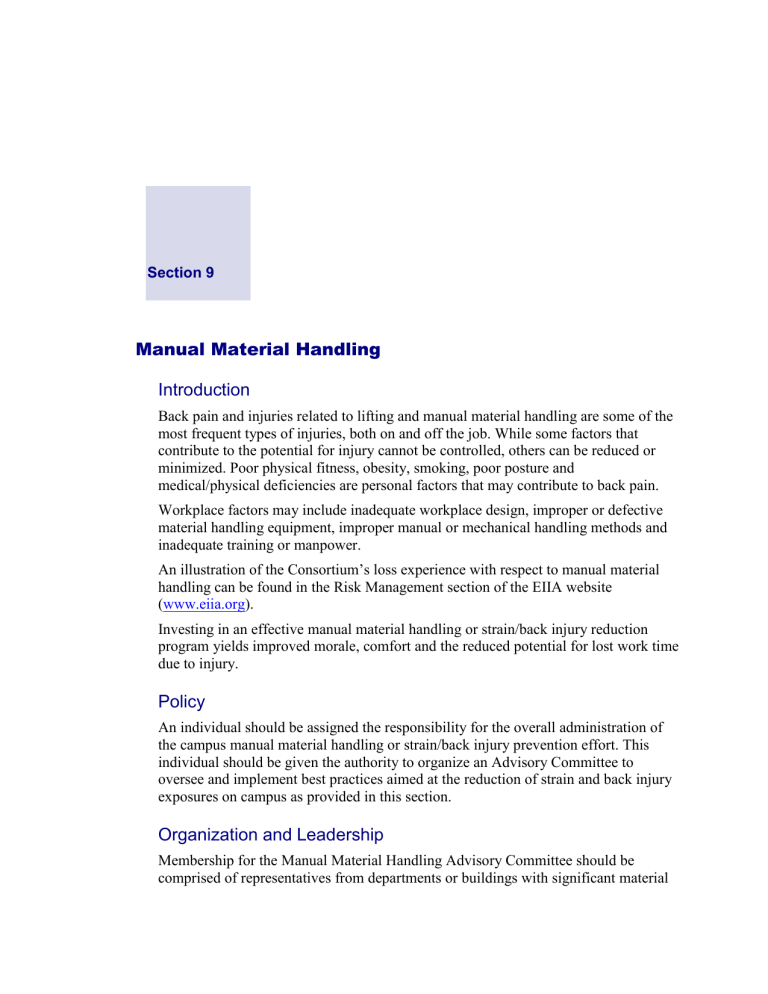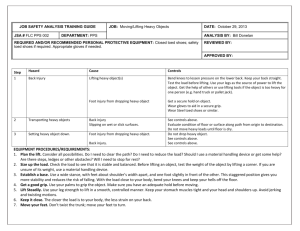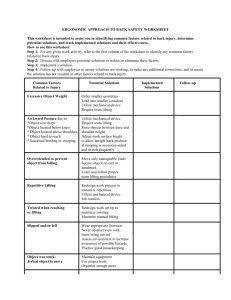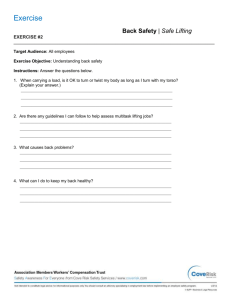Section 9 - St. Olaf College

Section 9
Manual Material Handling
Introduction
Back pain and injuries related to lifting and manual material handling are some of the most frequent types of injuries, both on and off the job. While some factors that contribute to the potential for injury cannot be controlled, others can be reduced or minimized. Poor physical fitness, obesity, smoking, poor posture and medical/physical deficiencies are personal factors that may contribute to back pain.
Workplace factors may include inadequate workplace design, improper or defective material handling equipment, improper manual or mechanical handling methods and inadequate training or manpower.
An illustration of the Consortium’s loss experience with respect to manual material handling can be found in the Risk Management section of the EIIA website
( www.eiia.org
).
Investing in an effective manual material handling or strain/back injury reduction program yields improved morale, comfort and the reduced potential for lost work time due to injury.
Policy
An individual should be assigned the responsibility for the overall administration of the campus manual material handling or strain/back injury prevention effort. This individual should be given the authority to organize an Advisory Committee to oversee and implement best practices aimed at the reduction of strain and back injury exposures on campus as provided in this section.
Organization and Leadership
Membership for the Manual Material Handling Advisory Committee should be comprised of representatives from departments or buildings with significant material
handling/lifting activities such as Physical Plant, Library, Book Store, Business
Office, Athletics, etc. Committee positions should be rotating with one-fourth to onethird of the members rotating each year. The activities of the Advisory Committee should be reported to the Campus Risk Management/Safety Steering Committee.
Training
Top priority should be given to the elimination or the reduction of lifting activities on campus that present strain/back injury exposures. Training of campus personnel in several key aspects of proper lifting and material handling techniques, as well as improved job and task planning, will assist in reducing the frequency of these occurrences on your campus.
Provided below are a number of training best practices that should be considered.
A minimum of one individual within each department should receive training in the following areas:
How to identify potential exposures
How to evaluate a job or task
How to reduce or eliminate the exposure
Individuals who engage in lifting and material handling as part of their work should receive training in the following:
Performing stretching and warm-up exercises prior to engaging in lifting activities
Using the proper personal protective equipment such as gloves and protective shoes
Taking time to size up the load and getting help for heavier lifts
Using proper lifting techniques (e.g. object close to the body, back straight, avoid twisting, lift with the legs, etc.)
Using mechanical lifting aids for oversized or bulky loads
Lifting Best Practices
Safe lifting is a function of the amount of weight being lifted and the technique being used. Always test the weight before lifting. If it is too heavy, have someone help or use mechanical lifting aids. The following are helpful hints on the use of proper lifting techniques:
Know where you are going before lifting the load. Pre-plan the lift.
Keep your feet shoulder width apart for good balance.
Take a deep breath and tighten your stomach muscles just prior to the lift. Conditioned stomach muscles provide excellent support for the lower back.
Bend at your knees not your hips.
Lift using your leg muscles to reduce the load on your back.
Lift smoothly and avoid jerking the load. Sudden movement and weight shifts can injure your back.
Hold the load close to your body. The further the load is from your body, the greater the stress to your lower back.
Turn with your feet and avoid twisting.
Job/Task Evaluation
When jobs or tasks are identified that have resulted in or have the potential to result in strain or back injury, it is recommended that they be evaluated in order to quantify the seriousness of the exposure. Doing so will help to identify the specific contributing factors and can be a basis for prioritizing jobs or tasks for redesign or elimination. The following factors should be considered:
Weight— The weight being lifted or carried will be the primary risk factor to be considered. The greater the weight, the more stress placed on the lower back.
Location of the Object/Item— The further the object to be lifted or carried is away from the body, the greater the stress placed on the lower back. The lower back works very much like a lever. The further the weight is located from the fulcrum of a lever the harder it is to lift. Ideally, loads should be as close to the body as possible.
Size and Shape of the Object— If the object is bulky or difficult to get your arms around, even a relatively light load can pose a back injury hazard.
Frequency/Duration/Pace— Fatigue can occur when working at a high frequency task over a long period of time or at a high pace. This may be a factor when handling large shipments of books, furniture, equipment, etc. Susceptibility to injury increases with the onset of fatigue.
Stability of the Load— If liquid or another unstable product is being lifted or carried, the center of gravity can easily shift, resulting in a loss of balance. An attempt to “catch” the shifting center of gravity can result in muscle strain.
Couplings— This includes having stable footing and the ability to have a good grip on the object during the lift. Attempts to catch oneself when slipping or attempting to catch the object slipping from the hands can result in strains or other fall or struck by related injuries.
Note that all of these risk factors are included in the Manual Material Handling Risk
Factor Checklist. (See Appendix 9-A ) This checklist can be utilized to evaluate the
potential risk factors associated with lifting tasks on campus.
It is suggested that emphasis be placed on the evaluation of the following jobs/tasks on campus:
Loading and unloading of vehicles and trailers
Hitching and unhitching of trailers
Using carts for the transport of books, materials, etc.
Handling and disposal of trash bags and containers
Moving furniture and mattresses
Connecting and disconnecting attachments from equipment
Such manual material handling activities have resulted in a significant number of back and general strain type injuries Consortium-wide.
Eliminating and Reducing Exposures
Once “problem jobs or tasks” are identified and have been evaluated, as described in the preceding section, consideration should be given to redesigning the tasks. The following concepts should be applied where possible:
Eliminate the Task— Determine if the task can be eliminated all together. For example, can the material currently delivered in bags be delivered in bulk and dispensed in controlled amounts or can mechanical means be used to eliminate the manual handling altogether.
Another option may be to contract out infrequent, high hazard tasks such as piano moving, moving furniture and mattress change out.
Reduce the Weight— Use lighter materials where possible such as plastic in place of metal or use smaller containers such as 25-pound bags instead of 50- or 100-pound bags.
Reduce Horizontal Reaches— The further the load is positioned away from the body the greater the stress on the lower back. Where possible, items should be positioned so that they can be lifted close to the body. For example, store heavier materials near the front of racks and shelves to reduce reaching and pulling.
Reduce Bending— Where possible, heavier boxes and materials should be stored at or near waist level. Bending significantly increases the amount of stress on the lower back.
Inspect the Object to be Moved— Before moving an object, inspect the object for protruding sharp points that may cause injury to the worker during the transport. Pad or remove any sharp points before moving the objects.
Use Material Handling Aids— Dollies and carts should be provided where materials are commonly handled. Specialized material handling equipment is also available for moving loads up and down stairs. (See listing of material handling equipment Web sites on page
9-5.)
Reduce Duration of the Task— Assignment of a greater number of employees to perform problem tasks will reduce both the amount of time to complete the task and the amount of lifting and bending performed by individual employees.
Reduce Work Above Your Head— Use a ladder that is tall enough so that you can work at elbow or eye height. Don’t try to stand on a shorter ladder and increase your overhead reach. This will place great stress on your neck, shoulders and arms. Take a break every few minutes to relieve some of that stress and use lightweight tools if possible.
Manual Material Handling Equipment
A formal evaluation should be conducted to determine if adequate material handling aids such as dollies for handling boxes, carts for books, fork trucks for handling large
deliveries, etc., are provided where needed on campus. Where deficiencies are found, such equipment should be provided or budgeted.
The following Web sites contain information on material handling equipment: www.wescomfg.com
www.escalera.com
www.industromart.com
www.dutro.com
Back Belts
Back belts are a controversial addition to the techniques used in the prevention of back injuries. The goal of the back belt is to impose a fixed posture on the wearer, making it difficult or impossible to bend or twist while lifting. It should be noted that back belts are not considered personal protective equipment by OSHA and are not specifically covered by existing regulations.
Departments that choose to allow their workers to use back belts should develop a policy on back belt use that covers the following:
Information on the pros and cons of back belts
Participation in any back belt program should be voluntary
Back belts should be permitted only after the employee has received and understands training in back belt use, proper lifting techniques and back care.
Training and Information Web sites
On-line training modules covering the information outlined above can be found on the following Web sites: www.free-training.com
www.ergonext.com
Appendix 9-A
Sample Manual Material Handling Risk Factor Checklist
Department: Task/Job:
Date:
Manual Handling Risk Factors Yes No
Does the task involve
Holding the load away from the body?
Excessive body movement or extreme posture such as twisting or stooping?
Carrying more than 10 feet?
Excessive pushing or pulling?
Prolonged physical effort? (Task performed for more than 2 hours without break)
Is the load
Heavy? (Over 40 pounds)
Bulky? (Hard to get arms around)
Difficult to grasp? (No hand holds)
Unstable? (Contents likely to shift)
Potentially damaging to the hands? (Sharp edges)
Are there
Space constraints that prevent good posture?
Uneven or slippery floors?
Variations in floor or work surface levels?
Extremes of temperature or humidity?
Does the job
Require unusual strength, height, etc.?
Create a hazard for those who are pregnant or have health problems?
Require special knowledge or training for its safe performance?
Where risk factors have been identified above, determine if they can be reduced or eliminated. (See the



